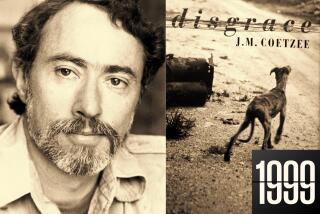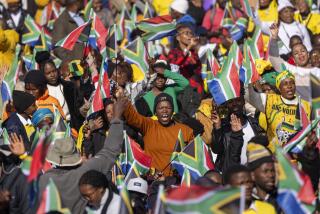ANATOMY OF A MIRACLE: The End of Apartheid and the Birth of the New South Africa.<i> By Patti Waldmeir</i> .<i> W. W. Norton & Co., 303 pp., $27.50</i>
- Share via
The new South Africa is truly a modern miracle. A nation that a decade ago seemed to many to be heading for a murderous race war has moved from apartheid and minority white rule to a young democracy, as vibrant at its grass roots as in its parliament. A society where survival for some people appeared possible only with the oppression of others now worries, as do all societies, about housing and education, jobs and crime. This transition has not been without pain--many problems are acute and worsening--but it has always been with hope.
South Africans, blacks and whites together, have defied those who could not envision majority rule with one-person, one-vote coming without an even greater conflict than the country experienced in the 1980s. The African National Congress similarly has defied those who portrayed it as a new oppressor party led by hard-line Communists that would establish a socialist state, seize the country’s wealth and impose a Stalinist regime.
But those who predicted the worst for South Africa simply did not understand the love, indeed the passion, that virtually all South Africans have for their country. It was this deep, almost unique patriotism, as much as their own suffering, that led black South Africans to demand their birthright through generations of struggle and that brought whites to accept, in the words of the 1955 Freedom Charter, that “South Africa belongs to all who live in it, black and white, and that no government can justly claim authority unless it is based on the will of the people.”
Patti Waldmeir, the Johannesburg correspondent for London’s Financial Times for seven years, gives the first good behind-the-scenes account of South Africa’s transition, particularly the tough negotiations that led to the 1994 elections and the adoption last year of a new constitution. This is a journalist’s book, and historians will want to analyze those negotiations again once they have access to position papers of all the parties--and the hindsight needed to assess the new government’s successes and failures. For now, however, Waldmeir’s “Anatomy of a Miracle” takes up where the veteran South African journalist Allister Sparks ended in his compelling chronicle of the anti-apartheid struggle, “The Mind of South Africa.”
Waldmeir writes with open admiration for the men and women who led South Africa’s democratic-rebirth--not only President Nelson Mandela but his predecessor, F. W. DeKlerk. Of Mandela, she says: “Mandela is not a man of God; he is a politician. He is a schemer, a conjurer, a manipulator of men--and that made him a great statesman. No saint could have done as much to produce South Africa’s miracle.” Of DeKlerk: “Not so much a good man--though he was that, too--as a smart politician, a perfect hero for the reasonable revolution. . . . [He] gave his heart and soul to the democratic revolution that had so terrified his forebears.”
She nonetheless is cautious in assessing the future: “When South Africa stepped through the looking glass, it did not emerge in Wonderland. It emerged in the real world, where poverty is the biggest challenge to all democratic governments and where there are tougher problems than apartheid. The skills and strengths South Africans evolved in the battle against that system have so far served them well in their new struggle; the democratic center--constructed so painfully over those years of negotiated revolution--continues to hold. The politics of common purpose, forged from so many different and conflicting interests, has continued to prevail.”
Waldmeir’s focus on the leaders and their lieutenants during the prolonged constitutional negotiations, however, minimizes the power of South Africa’s revolution, which was fought in the streets of a thousand dusty black townships and that reached its pivotal point when DeKlerk’s predecessor, P. W. Botha, realized that the country had indeed been made “ungovernable.” This was a revolt that could not be choked off, that in time would threaten the survival of his Afrikaner people, that made the ANC a negotiating partner. And Botha then began secret discussions with the imprisoned Mandela and the exiled ANC leadership as protests grew. Without the popular rebellion of the 1980s, the constitutional negotiations of the 1990s would not have occurred.
But Waldmeir correctly assesses the ANC’s acceptance of white South Africans, particularly the Afrikaners, as the foundation for national reconciliation. “Mandela did not so much forgive his captors as try to understand them,” she writes of his 1963 imprisonment on treason charges. “He spent a lifetime studying their mental pathology, and 27 years in prison devising ways to cure it. He condemned their policy without condemning them as human beings, and set them free from the bondage of a fear they could not conquer on their own.”
One reason for the ANC’s open-armed acceptance of whites in the face of strong African nationalism was the participation in the anti-apartheid struggle by white liberals who sided with the United Democratic Front in the 1980s, who sympathized with the Black Consciousness Movement in the 1970s and who for more than four decades went into exile rather than participate in, and benefit from, an immoral system. White members of the South African Communist Party, notably the late Joe Slovo, did much to preserve the ANC’s “non-racialism” by their own commitment to it.
As an American who grew up amid the bitter racial divisions of Detroit, Waldmeir seeks broader lessons in South Africa’s miracle, lessons that could bring greater racial harmony to the United States. “If the ANC can look beyond black and white, how dare I refuse to do so?” she asks.
But the experience of South Africa, indelible as it is for many Americans, myself included, is different from the American experience. South Africa suffered from an almost colonial oppression of the country’s majority by a racial minority; America endured the enslavement of a minority by a racial majority. A hundred years after the Civil War, desegregation was at last dismantled and enfranchisement of the racially excluded became the order of the day. Progress was made. But a huge gap remains. Too often, we Americans, while officially committed to equality for all, privately still fail to achieve that goal. Too many of us seem still to resent its challenge. Suspicion between the races abounds.
South Africa, by contrast, despite the harsh struggle that was waged--a struggle that might well have deepened division and resulted in lasting bitterness--seems, so far, to have escaped the bloody fate that so many predicted. Instead, there is a recognition by both blacks and whites in the new South Africa of each other’s humanity. Today, whites and blacks in South Africa understand one another across the racial barrier better perhaps than black and white Americans know each other. Surely this is at the heart of the South African miracle.
More to Read
Sign up for Essential California
The most important California stories and recommendations in your inbox every morning.
You may occasionally receive promotional content from the Los Angeles Times.













